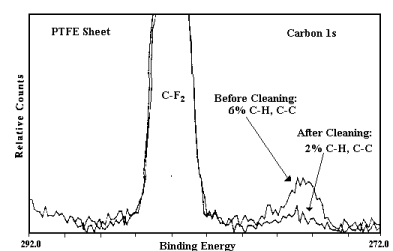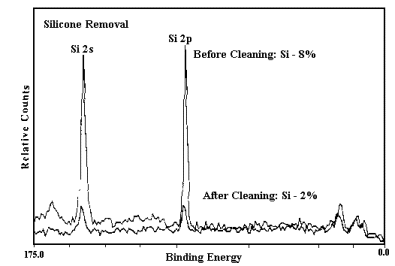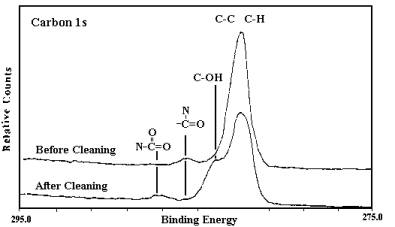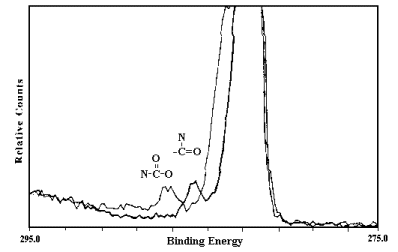Polymers
Carbon dioxide snow cleaning has been used on many polymers. In general, snow cleaning can remove contamination from polymer surfaces without removing the base polymer. The reason is that crosslinked organics, such as polymers, are not readily soluble in liquid carbon dioxide while contamination such as long hydrocarbon chains are still soluble. The examples shown below include snow cleaning of a PTFE sheet and two polyetherurethane catheters.
PTFE Sheet
A piece of clean teflon sheet was taken and analyzed using XPS. Initial surface analysis showed about 6 atomic % hydrocarbons on the surface along with a small oxygen peak (0.5%). After snow cleaning, the hydrocarbon peak only accounted for 2% of the area, a reduction in 75% of contamination from the surface. Further, the small oxygen peak was gone. The figure below shows the carbon 1s XPS spectra before and after cleaning. The strong C-F peaks were normalized to the same height and are off scale.

Silicone Coated Catheter
The second sample shown here is a polyetherurethane (PEU) catheter with about 8 atomic percent silicon (as a silicone) on the surface. This silicone is in the manufacturing process. After snow cleaning, the silicone content reduced to 2 at. %. This value of 2% is typical of a monolayer. All overlayers were removed. The extent of cleaning is expected on theoretical grounds. The figure below shows the XPS spectra of the silicon peaks before and after cleaning.

Amide Wax Removal
A piece of a different PEU catheter was examined. This piece is manufactured with an amide wax to assist in processing and this wax needs must be removed; its biocompatibility properties are not suitable for human use. The initial XPS scans of the carbon region showed a strong hydrocarbon peak and a small amide side peak. The expected ether and urethane linkages are not seen. After cleaning, the amide peaks disappeared and the expected polyether and urethane peaks are clearly seen. These changes are highlighted in the figure below showing the carbon 1s peaks before and after cleaning.


Scanning electron microscopy was also used to study the microstructural changes on this amide coated catheter. The images below, obtained at 10,000 times, show the initial surface typically covered with debris. After snow cleaning the surface is much cleaner. Please note, to study polymers in an SEM, we coated the catheter with a thin metal layer to assist in imaging. Therefore, the same regions were not used for the before and after images.

